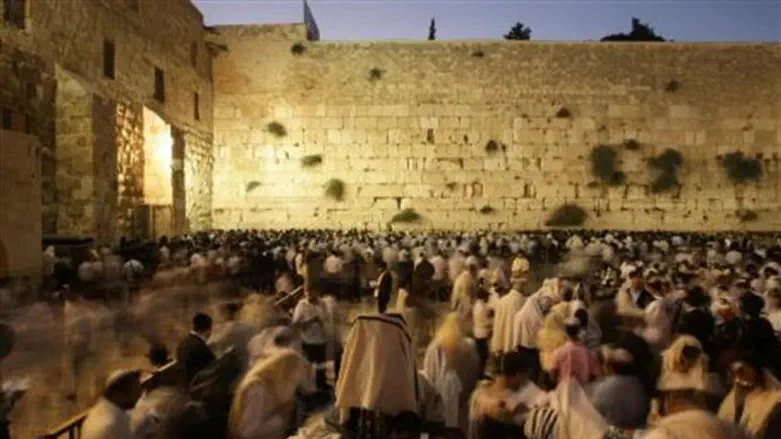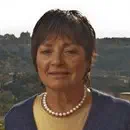
Reposted from 2022. May it be G-d's Will that the Beit Hamikdash be rebuilt speedily in our times..
The Book of Lamentations (Megillat Eikha in Hebrew, one of the five megillahs incorporated into the Tanakh), is read in the synagogue on the fast of the 9th of Av, as are kinot (elegies) describing the tragedies undergone by the Jewish people. After shul on that day, my mother z"l would sit on the ground with me and other friends, as she must have once done as a girl in Europe, and read aloud - in Yiddish - midrashic accounts of Jerusalem at the time of the Temple's destruction.
I carried on the tradition in Hebrew, reading the midrashic narratives in Kol Aggadat Yisrael with my daughter, named for the grandmother she never knew. Although midrashic books in modern Hebrew abound, the archaic Hebrew in those volumes made me feel that I was there in Jerusalem, suffering with its inhabitants. I remember those Tisha B'Av summer mornings as a time of sadness, identification with Jerusalem's pain, and deep longing for the rebuilding of the Temple.
My mother– who had lost her own mother at the age of eight and three siblings and some of their children to Hitler – also loved to sing the uplifting song from Chapter 3 of Eikha: "Chasdei Hashem ki lo tamnu ki lo chalu rachamav, G-d's kindness is endless, his mercy continues forever, " and I can still hear her high, sweet voice singing it with me as a child.
These were wholly emotional experiences, which I strongly believe, as she did, are crucial for passing on Jewish tradition, faith and values to youngsters. And inculcating a love for learning Torah that goes beyond pride in intellectual accomplishment is a part of that tradition.
Now that the study of Tanakh is extremely widespread in the Orthodox world, parts of it that were normally glossed over are being taught in depth, but Eikha is seldom, if ever, included in that endeavor except, perhaps, during the Three Weeks between the 17th of Tammuz and the Fast of the 9th of Av. For me, at least, my connection with Eikha remained the yearly emotional reading of my growing years, so when I was asked to review Dr. Yael Ziegler's new book on Lamentations, it seemed a welcome opportunity to approach the text from an objective, analytic and scholarly point of view – and I was not disappointed.

Dr. Ziegler, a most erudite and dedicated Torah scholar just appointed to head Matan Jerusalem and whose emunah and yirat shamayim (faith in and awe of G-d) permeate her work, has written an organized, thoroughly researched and most fascinating book combining both traditional and carefully selected academic sources.
She begins with the historical context, followed by a general preface to the thematic portrayal of suffering and faith that is the crux of Eikha. In the next chapter, which introduces Biblical poetic techniques and characteristics, the reader is made aware of how the imagery, sound patterns and metaphors employed in the text add to that feeling of tragedy. The rest of the book notes these techniques as they appear, for example, the metaphor of widowhood, the use of the word gold as a symbol, and the effect of the juxtaposition of "my eyes rain tears" and a plea to G-d to figuratively use His "eyes" to see the brutality rained on His people. The narrator begs Him to be moved by the contrast between the lives once led by Jerusalem's leaders and elite, by its women and children - and their present unbearable degradation.
I was especially intrigued by the theory describing the difference between the parallelism in the meter of most Biblical poetry and that of Biblical kinot – termed kina meter by Karl Budde, a metric that pulls you downward, as the lamenting words do, at the end of each verse.
Theological questions raised in Eikha are a central and essential part of this book, which also points out issues of communal and individual guilt, punishment, forgiveness, repentance, revenge and belief that arise in the text, leading to an overwhelming question: How are the Jewish people to go on? There is no relief to be found in Eikha, just a despairing plea at the end for G-d to allow us to return after He has rejected us so wrathfully.
How the Sages dealt with that seemingly hopeless situation is the subject of an eye-opening chapter (at least for me) on the later midrashic work Eikha Rabba towards the end of the book, whose content Ziegler sees as "wise and compassionate messages that support Israel through the difficult years of exile." She concludes that it is "Chazal's ability to understand Israel's present and future needs" that facilitated not only survival but the ability to "flourish in the aftermath of catastrophe." Continuing in that vein, the beautifully written last chapter leaves readers with the message that "the experience of adversity can foster faith in a turbulent world."
Ziegler has dedicated a separate chapter for each of the five chapters in Eikha, the titles of which are the essence of each chapter's particular atmosphere. For each, there is an introduction, an analysis of structure, an exposition of grouped verses with special attention to specific words and expressions, and a summation which gives an overall view, with appendices added when the author deems it necessary. Theological and psychological themes are reflected upon and discussed, sometimes as part of the chapter's development and sometimes connected to specific verses in which the ideas appear.
Chapter 1, for example, is aptly titled A Desolate City, its twenty-two alphabetically ordered verses divided into two parts: the narrator's account of desolation, loneliness and crisis up to the middle and then Jerusalem's own eerie account from there to the end. There are two appendices, the first positing the chapter's chiastic structure (a literary Biblical phenomenon explained in the chapter on biblical writing techniques which in a later chapter is posited as the overall structure of Lamentations), the second discussing the word "Eikha."
Chapter 2 is summed up by its title, Destruction and Anger, its orderly recounting of Jerusalem's destruction ending with bafflement, outrage and accusations aimed at G-d. Chapter 3, which Ziegler calls the central axis of Eikha and written as a triple acrostic, is fittingly called by her The Suffering of the Individual, as it is the words of the "man who has seen affliction" – referring to its writer, Jeremiah, according to Rashi, an opinion Ziegler buttresses by showing verses in the Book of Jeremiah that echo those in this chapter. Chap 4 is seen as a factual Chapter of Numb Pain while Chap 5, Communal Petition and Lament, has a direct and evocative appeal to G-d.
The 500 page book allows for individualized reading. One can begin with the introductory chapters and then delve into the others at will, or use them as a source for concentrating on specific verses or unusual words that need clarification. Ziegler has done thorough etymological research into word meanings, and from a literary aspect, shows how motifs in the text are often derived from the number of times key words appear in it.
A major accomplishment is the set of tables containing the comparison of many of Eikha's verses to those in other Biblical books. The Tochacha admonitions ( in the Torah portions of Bechukotai and Ki Tisa) are juxtaposed with Eikha's descriptions of the catastrophe, and the wording has so many similarities that one cannot help wondering if Jeremiah did this intentionally so that his listeners would connect the explicit Biblical warnings with the punishment they are experiencing. Chapters of Psalms are compared as well, but most impressive is the comparison by contrast to verses of consolation in Isaiah showing that many of the verses in Eikha are turned around verses of Isaiah. The Prophet Isaiah's 8th century BCE visions of return and redemption at the time of the exile of the ten tribes become Jeremiah's description of destruction in the 6th. Interestingly, on each of the seven Sabbaths from the 9th of Av to Rosh Hashanah we read one of Isaiah's "seven chapters of consolation" in synagogue after the Torah portion.
Reading the comparisons to the prophecies of Isaiah, the commendable scholarship that brought it to my attention suddenly led to a moment of moving enlightenment, much like the emotional experience of my younger years. Before perusing the tables, I had never thought of comparing Eikha to Isaiah, but suddenly realized that most of the people of ancient Jerusalem hearing Jeremiah chanting Eikha did not need, as I did, to read about those similarities. They must have known many of the verses of Isaiah, Psalms and the Tochacha by heart. The contrasts and comparisons that use the same words and expressions were in all probability obvious to them, just as we, too, recognize and quote more recent famous literary expressions.
Suddenly, I could see them before me, standing with heads bowed, listening to Jeremiah, remembering Isaiah's promises of future redemption and recognizing the truth of the Tochacha's warnings.
Thank you, Dr.Zeigler, not only for adding immeasurably to our understanding of Eikha itself, but for the comparative reading that brought it to life.
May we merit the Redemption and rebuilding of our Temple in the Holy city of Jerusalem.
Rochel Sylvetsky made aliya to Israel with her family in 1971, coordinated Mathematics at Ulpenat Horev, worked in math curriculum planning at Hebrew U. and as academic coordinator at Touro College Graduate School in Jerusalem. She served as Chairperson of Emunah Israel and was CEO of Kfar Hassidim Youth Village. Upon her retirement, Arutz Sheva asked her to be managing editor of the English site, a position she filled for several years before becoming Senior Consultant and Op-ed and Judaism editor. She serves on the Boards of Orot Yisrael College and the Knesset Channel.
..
